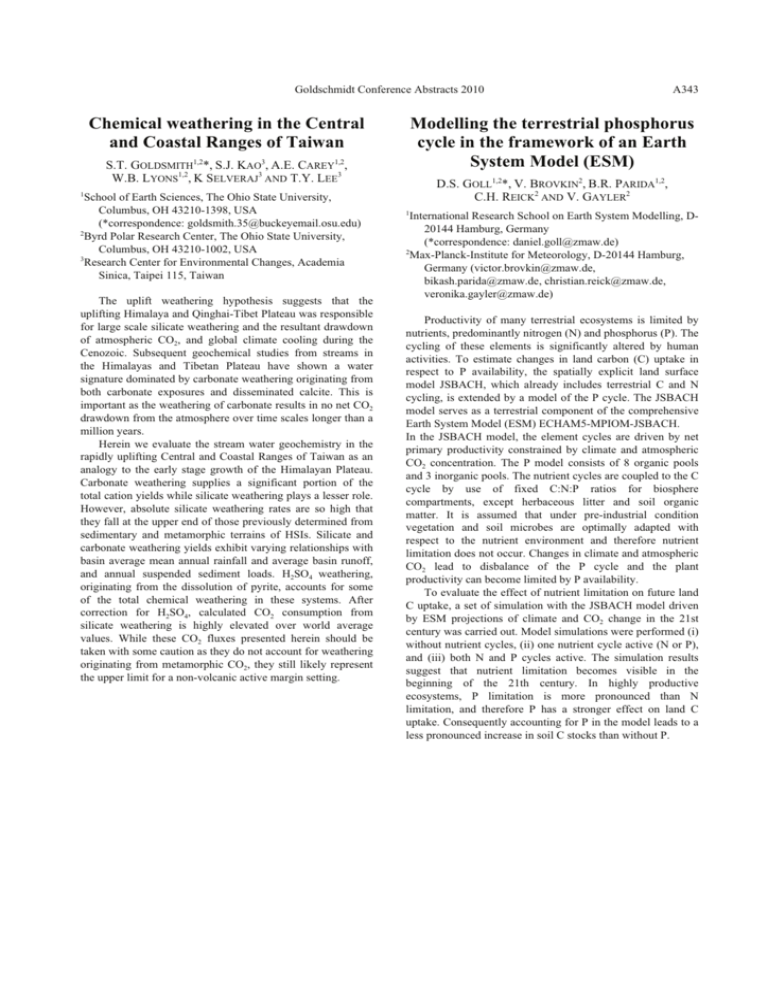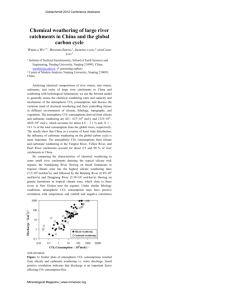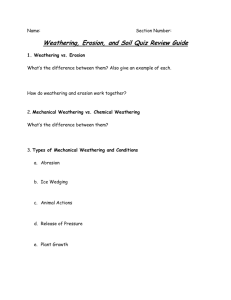Chemical weathering in the Central and Coastal Ranges of Taiwan
advertisement

Goldschmidt Conference Abstracts 2010 Chemical weathering in the Central and Coastal Ranges of Taiwan Modelling the terrestrial phosphorus cycle in the framework of an Earth System Model (ESM) S.T. GOLDSMITH1,2*, S.J. KAO3, A.E. CAREY1,2, W.B. LYONS1,2, K SELVERAJ3 AND T.Y. LEE3 D.S. GOLL1,2*, V. BROVKIN2, B.R. PARIDA1,2, C.H. REICK2 AND V. GAYLER2 1 School of Earth Sciences, The Ohio State University, Columbus, OH 43210-1398, USA (*correspondence: goldsmith.35@buckeyemail.osu.edu) 2 Byrd Polar Research Center, The Ohio State University, Columbus, OH 43210-1002, USA 3 Research Center for Environmental Changes, Academia Sinica, Taipei 115, Taiwan The uplift weathering hypothesis suggests that the uplifting Himalaya and Qinghai-Tibet Plateau was responsible for large scale silicate weathering and the resultant drawdown of atmospheric CO2, and global climate cooling during the Cenozoic. Subsequent geochemical studies from streams in the Himalayas and Tibetan Plateau have shown a water signature dominated by carbonate weathering originating from both carbonate exposures and disseminated calcite. This is important as the weathering of carbonate results in no net CO2 drawdown from the atmosphere over time scales longer than a million years. Herein we evaluate the stream water geochemistry in the rapidly uplifting Central and Coastal Ranges of Taiwan as an analogy to the early stage growth of the Himalayan Plateau. Carbonate weathering supplies a significant portion of the total cation yields while silicate weathering plays a lesser role. However, absolute silicate weathering rates are so high that they fall at the upper end of those previously determined from sedimentary and metamorphic terrains of HSIs. Silicate and carbonate weathering yields exhibit varying relationships with basin average mean annual rainfall and average basin runoff, and annual suspended sediment loads. H2SO4 weathering, originating from the dissolution of pyrite, accounts for some of the total chemical weathering in these systems. After correction for H2SO4, calculated CO2 consumption from silicate weathering is highly elevated over world average values. While these CO2 fluxes presented herein should be taken with some caution as they do not account for weathering originating from metamorphic CO2, they still likely represent the upper limit for a non-volcanic active margin setting. A343 1 International Research School on Earth System Modelling, D20144 Hamburg, Germany (*correspondence: daniel.goll@zmaw.de) 2 Max-Planck-Institute for Meteorology, D-20144 Hamburg, Germany (victor.brovkin@zmaw.de, bikash.parida@zmaw.de, christian.reick@zmaw.de, veronika.gayler@zmaw.de) Productivity of many terrestrial ecosystems is limited by nutrients, predominantly nitrogen (N) and phosphorus (P). The cycling of these elements is significantly altered by human activities. To estimate changes in land carbon (C) uptake in respect to P availability, the spatially explicit land surface model JSBACH, which already includes terrestrial C and N cycling, is extended by a model of the P cycle. The JSBACH model serves as a terrestrial component of the comprehensive Earth System Model (ESM) ECHAM5-MPIOM-JSBACH. In the JSBACH model, the element cycles are driven by net primary productivity constrained by climate and atmospheric CO2 concentration. The P model consists of 8 organic pools and 3 inorganic pools. The nutrient cycles are coupled to the C cycle by use of fixed C:N:P ratios for biosphere compartments, except herbaceous litter and soil organic matter. It is assumed that under pre-industrial condition vegetation and soil microbes are optimally adapted with respect to the nutrient environment and therefore nutrient limitation does not occur. Changes in climate and atmospheric CO2 lead to disbalance of the P cycle and the plant productivity can become limited by P availability. To evaluate the effect of nutrient limitation on future land C uptake, a set of simulation with the JSBACH model driven by ESM projections of climate and CO2 change in the 21st century was carried out. Model simulations were performed (i) without nutrient cycles, (ii) one nutrient cycle active (N or P), and (iii) both N and P cycles active. The simulation results suggest that nutrient limitation becomes visible in the beginning of the 21th century. In highly productive ecosystems, P limitation is more pronounced than N limitation, and therefore P has a stronger effect on land C uptake. Consequently accounting for P in the model leads to a less pronounced increase in soil C stocks than without P.





